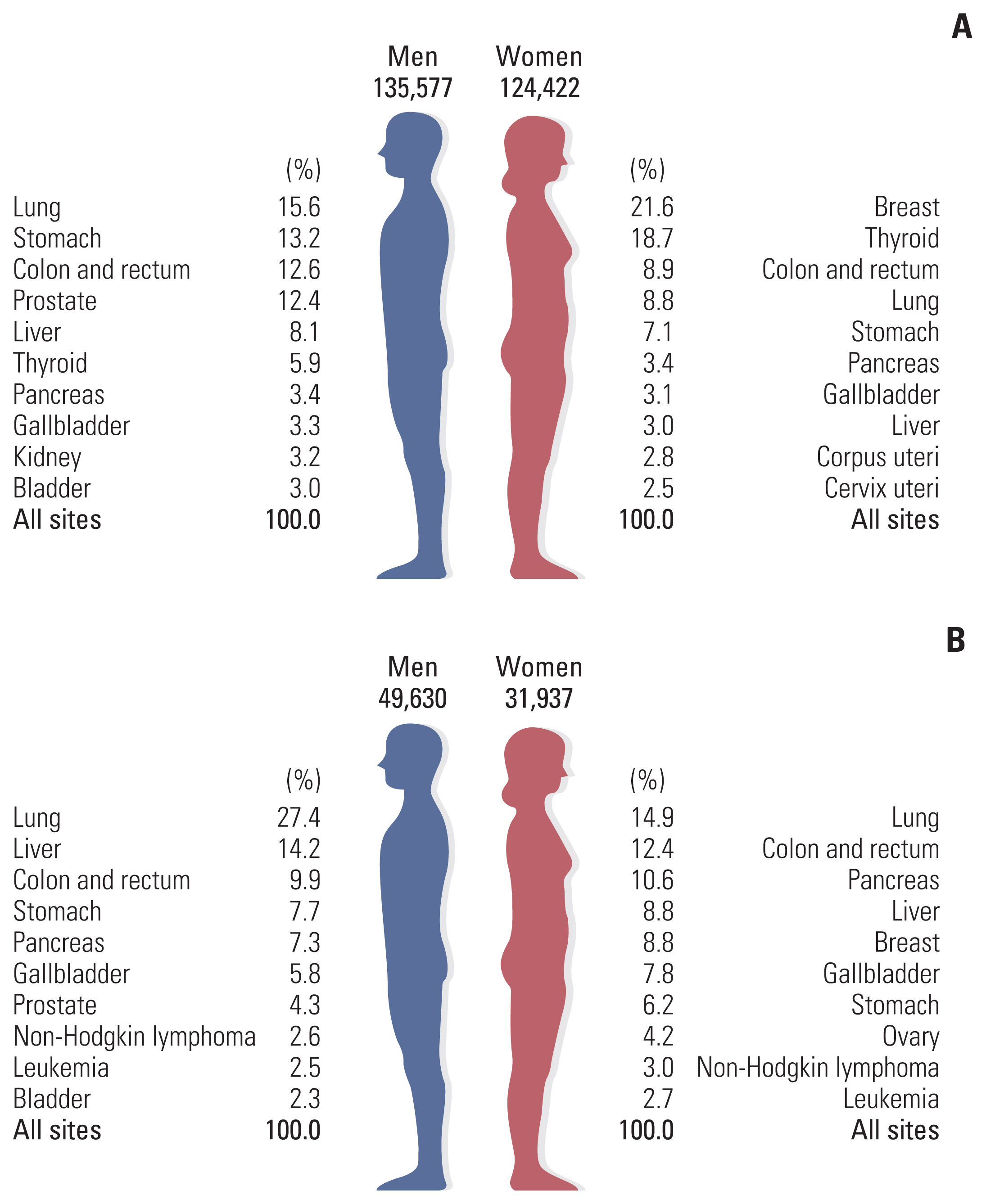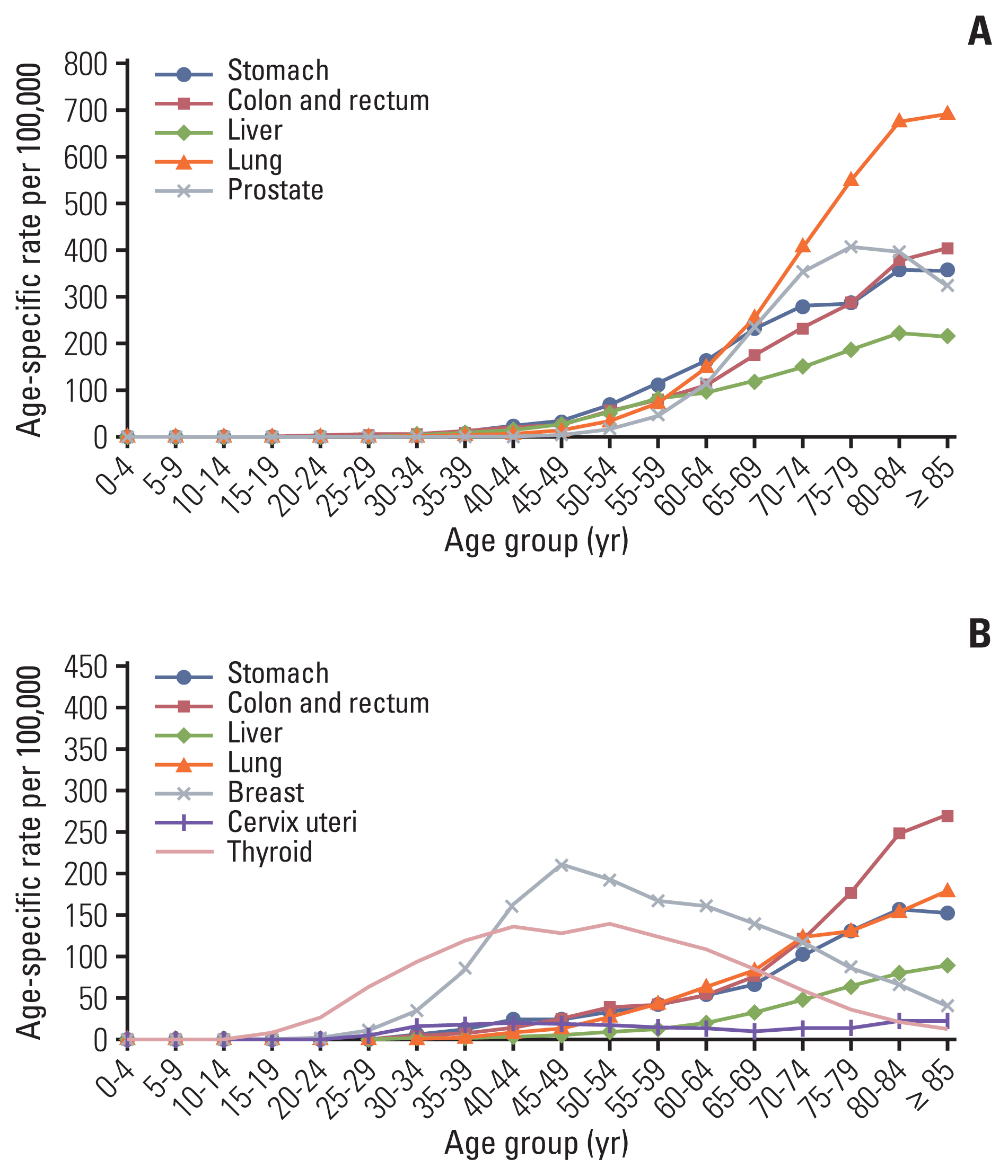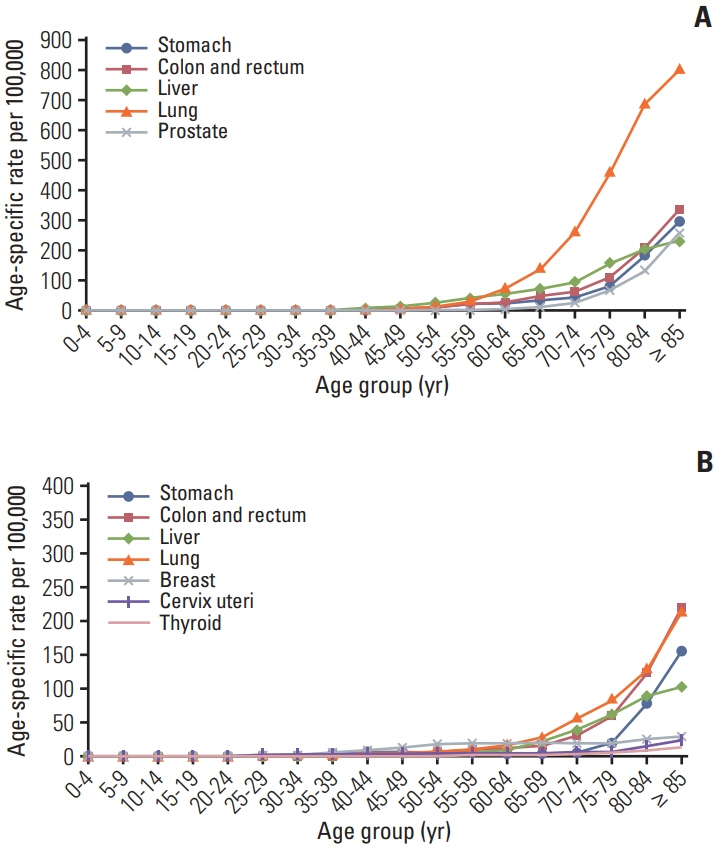Prediction of Cancer Incidence and Mortality in Korea, 2021
- Affiliations
-
- 1Korea Central Cancer Registry, National Cancer Center, Goyang, Korea
- 2Division of Cancer Registration and Surveillance, National Cancer Control Institute, National Cancer Center, Goyang, Korea
- 3National Cancer Center Graduate School of Cancer Science and Policy, National Cancer Center, Goyang, Korea
- 4National Cancer Control Institute, National Cancer Center, Goyang, Korea
- KMID: 2514914
- DOI: http://doi.org/10.4143/crt.2021.290
Abstract
- Purpose
This study aimed to report the projected cancer incidence and mortality for the year 2021 to estimate Korea’s current cancer burden.
Materials and Methods
Cancer incidence data from 1999 to 2018 were obtained from the Korea National Cancer Incidence Database, and cancer mortality data from 1993 to 2019 were acquired from Statistics Korea. Cancer incidence and mortality were projected by fitting a linear regression model to observed age-specific cancer rates against their respective years and then by multiplying the projected age-specific rates by the anticipated age-specific population for 2021. A joinpoint regression model was used to determine the year in which the linear trend changed significantly; we only used the data of the latest trend.
Results
In total, 259,999 new cancer cases and 81,567 cancer deaths are expected to occur in Korea in 2021. The most common cancer site is expected to be the lung, followed by the thyroid, colon and rectum, breast, and stomach. These five cancers are expected to represent half of the overall burden of cancer in Korea. The most common type of cancer leading to death is expected to be lung cancer, followed by liver, colorectal, pancreatic, and stomach cancers.
Conclusion
The incidence rates for all types of cancer in Korea are estimated to gradually decrease. These up-to-date estimates of the cancer burden in Korea could be an important resource for planning and evaluating cancer-control programs.
Figure
Cited by 4 articles
-
Trend Analysis and Prediction of Hepatobiliary Pancreatic Cancer Incidence and Mortality in Korea
Hyeong Min Park, Young-Joo Won, Mee Joo Kang, Sang-Jae Park, Sun-Whe Kim, Kyu-Won Jung, Sung-Sik Han
J Korean Med Sci. 2022;37(28):e216. doi: 10.3346/jkms.2022.37.e216.Seaweed and Iodine Intakes and
SLC5A5 rs77277498 in Relation to Thyroid Cancer
Tung Hoang, Eun Kyung Lee, Jeonghee Lee, Yul Hwangbo, Jeongseon Kim
Endocrinol Metab. 2022;37(3):513-523. doi: 10.3803/EnM.2021.1306.Cancer Rehabilitation Fact Sheet in Korea
Jin A Yoon, Bo Young Hong
Ann Rehabil Med. 2022;46(4):155-162. doi: 10.5535/arm.22102.A Nationwide Study of Differences in Surgical Treatment Rates and Oncological Outcomes for Prostate Cancer according to Economic Status and Region
Sangjun Yoo, Sohee Oh, Min Chul Cho, Hwancheol Son, Hyeon Jeong
Cancer Res Treat. 2023;55(2):652-658. doi: 10.4143/crt.2022.893.
Reference
-
References
1. Statistics Korea [Internet]. Daejeon: Statistics Korea;2021. [cited 2021 Feb 8]. Available from: http://kosis.kr .2. Hong S, Won YJ, Park YR, Jung KW, Kong HJ, Lee ES, et al. Cancer statistics in Korea: incidence, mortality, survival, and prevalence in 2017. Cancer Res Treat. 2020; 52:335–50.
Article3. Shin HR, Won YJ, Jung KW, Kong HJ, Yim SH, Lee JK, et al. Nationwide cancer incidence in Korea, 1999–2001: first result using the National Cancer Incidence Database. Cancer Res Treat. 2005; 37:325–31.
Article4. Fritz A, Percy C, Jack A, Shanmugaratnam K, Sobin L, Parkin DM, et al. International classification of diseases for oncology. 3rd ed. 1st rev. Geneva: World Health Organization;2013.5. World Health Organization. International statistical classification of diseases and related health problems. 10th rev. Geneva: World Health Organization;1994.6. Boyle P, Parkin DM. Statistical methods for registries. Jensen OM, Parkin DM, MacLennan R, Muir CS, Skeet RG, editors. Cancer registration: principles and methods. IARC Scientific Publication No. 95. Lyon: IARC Press;1991. p. 126–58.7. National Cancer Institute. Joinpoint regression program, version 4.8.0.1 [Internet]. Bethesda, MD: National Cancer Institute;2020. [cited 2021 Jan 28]. Available from: http://surveillance.cancer.gov/joinpoint/ .8. Segi M. Cancer mortality for selected sites in 24 countries 1950–1957. Sendai: Tohoku University School of Medicine;1960.




